



The firm was founded in 1819 by Jakob Kern (1790-1867) who had been apprenticed to Ludwig Esser. Initially producing drawing instruments, geodetic and astronomical instruments were also produced later. In 1988 it became part of the Wild Leitz Group and the Aarau factory closed in 1991. More details may be found on the “Milestones of Kern & Co AG” web site (see links and contacts). I have included sets by other Swiss makers on this page as well, including Gysi and Wild

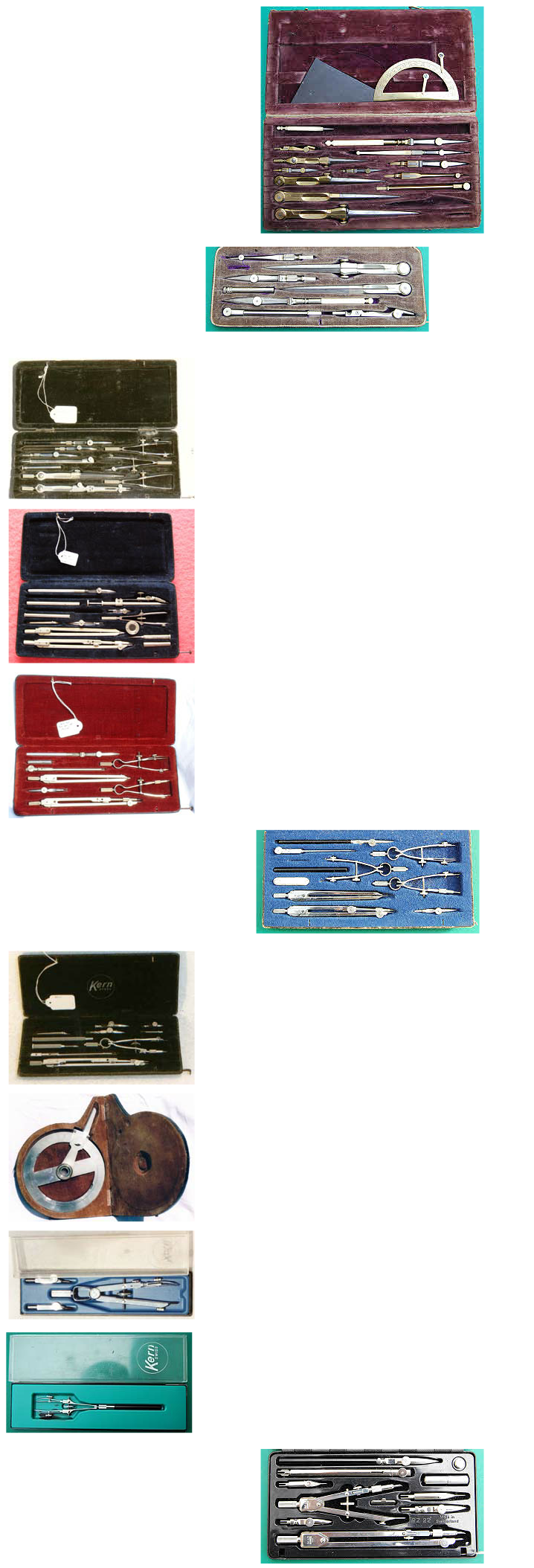

This nickel-silver set is quite probably by a Swiss maker. The purple velvet lining to the leather case has faded badly. It probably dates from about 1900.
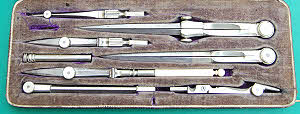
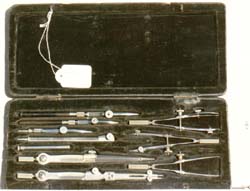
A Kern set dating from between 1914 and 1926. They are typical of quality, traditional pattern Swiss and German instruments from that period although in the process of being superceded by flat system instruments . The metal instruments are made of nickel silver.
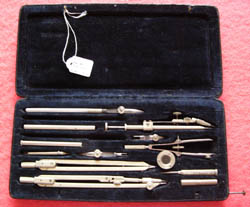
An early twentieth century set of flat pattern instruments, of higher quality than the next set. It is missing a ruling pen and extension bar. The instruments are again nickel silver.
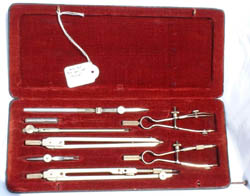
Kern B16 set. Another early twentieth century set of flat pattern, nickel silver instruments. The pen, although by Kern, is not original to the set and is probably older.
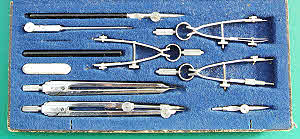
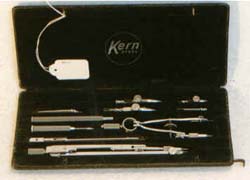
From the 1950s on imported instruments gained more and more ground in Britain. This small set is by the quality Swiss manufacturer, Kern of Aarau.
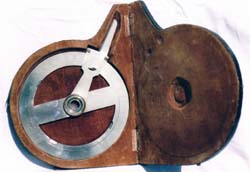
A Kern vernier protractor dating from before 1885. Vernier protractors were expensive but also more accurate than ordinary protractors. This one has a velvet lined leather case. The velvet was probably purple originally but has faded to light brown. The instrument is made of nickel-silver and six inches in diameter. The vernier reads to 3 minutes of arc

A Kern T2097K spring bow dating from the 1970s probably.
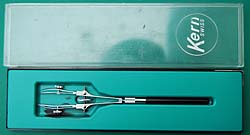
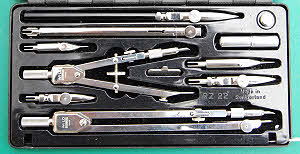
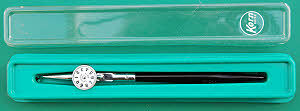

A selection of Kern items in green vacuum formed cases with clear vacuum formed lids. The first is a 11147 K compass.
The pen is a 1049
This bow compass is a 11087 K
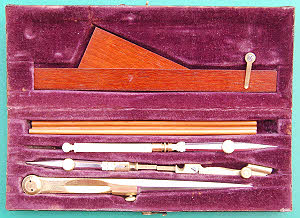
This Kern set probably dates from the mid-nineteenth century and is certainly pre-1885. The instruments are brass with finely polished steel parts and the pen handle is ivory. There are three unused thin pencils that fit the compass pencil point in the rectangular recess.

Kern Swiss section liner made from nickel silver and acrylic. The angle is adjustable and it is advanced by the thumb push in the lower right corner of the base-plate. The amount of advance is adjustable using the graduated thumb-wheel. It has a friction mechanism and return spring for the thumb push. There are two screw pins that hold the base-plate firmly in position
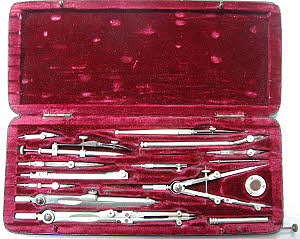
This Kern square pattern set dates from ca.1900. The ruling pen is a Kern replacement and the unusual spring bow is minus its ivory handle. Both legs are removable and it has two plain ones, for use as a divider, needle and pencil ones for use as a compass, and two ink ones for use as a compass or for drawing parallel lines, both being jointed so that they can be placed perpendicular to the paper.
I have since made a new handle for the spring bow.
I have since made a new handle for the spring bow.

|This set by Gysi, Aarau, dates from Ca.1870. Gysi made high quality instruments, like Kern. The square is Vulcanite. The set is missing a protractor and a compass key but is otherwise in good, original condition. The case is covered in black leather.
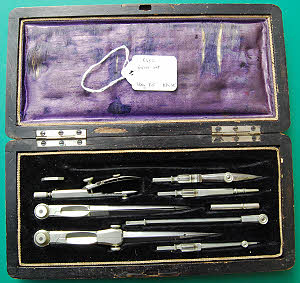
This set, in a stained wood case, is by an unknown maker, probably Swiss as the style is typically Swiss. The instruments are made of electrum. It is missing a ruling pen and probably dates from the end of the nineteenth century. Unusually the pencil lead insert is the collet type rather than the usual screw clamp type.
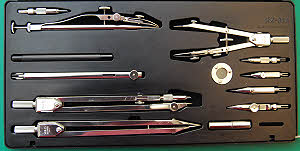
Wild Heerbrugg RZ-31A set dating from the 1950s/60s. Like the Wild set shown earlier it is made of stainless steel and housed in an aluminium case.
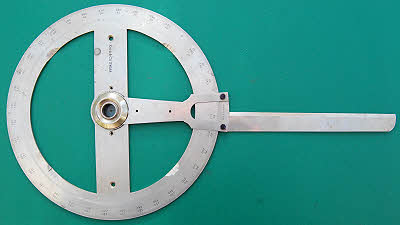
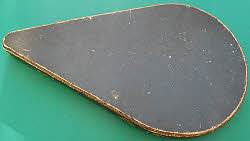
Nine inch diameter vernier protractor by Kern & Co, made of electrum (nickel silver). The vernier reads to one minute of arc. The shaped and fitted case is lined with deep red velvet and silk. Ca.1900
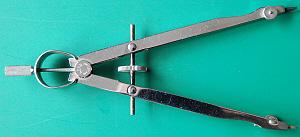
Kern six inch pencil spring bow compass, 1950s/1960s.


Wild System Riefler RZP 31 set. These instruments were made by Riefler in Germany for Wild except for the detail pen, which is marked Wild Swiss. They are polished chrome plated brass with plastic gears in the heads.


Kern A134 Hartchrom set in a metal case, probably dating from the 1980s
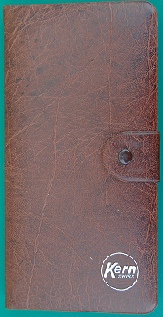
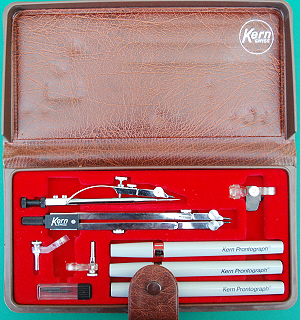
Kern set with three Prontograph pens dating from the 1980s. The compass is telescopic.
| Early Sets |
| Traditional Sets |
| Later Sets |
| Major Makers |
| Instruments |
| Miscellanea |
| W F Stanley |
| A G Thornton |
| W H Harling |
| Elliott Bros |
| J Halden |
| Riefler |
| E O Richter |
| Kern, Aarau |
| Keuffel & Esser |
| Compasses |
| Pocket compasses |
| Beam compasses |
| Dividers |
| Proportional dividers |
| Pens |
| Pencils |
| Rules |
| Protractors |
| Squares |
| Parallels |
| Pantographs |
| Sectors |
| Planimeters |
| Map Measurers |
| Miscellaneous |
| Materials Used |
| Who made them |
| Who made these |
| Addiator |
| Addimult |
| Other German |
| USA |
| Miscellaneous |
| Microscopes |
| Barometers |
| Hydrometers & Scales |
| Pedometers |
| Surveying Instruments |
| Other instruments |
| Workshop Measuring Tools |
| Catalogues & Brochures |
| Levels & Theodolites |
| Compasses & Clinometers |
| Miscellaneous surveying |
| Micrometers & Verniers |
| Engineering rules and gauges |
| Wood rules & calipers |
| Dial gauges & miscellaneous |